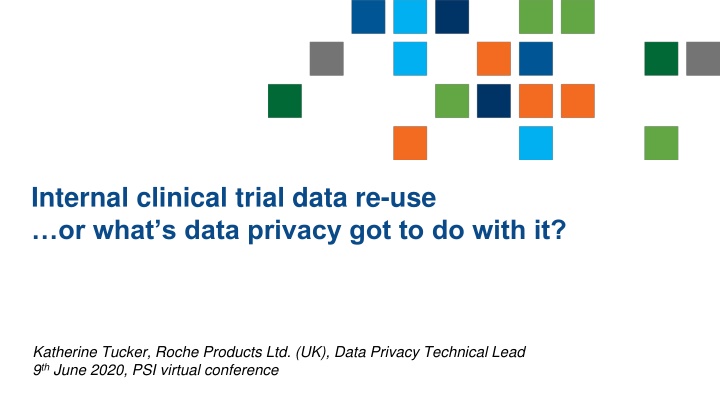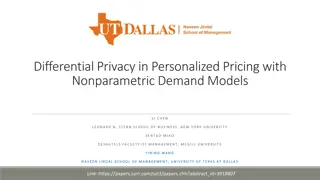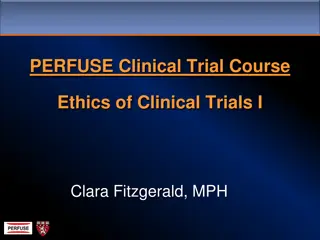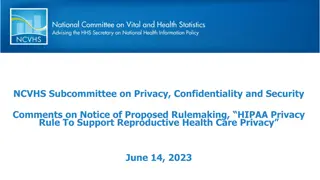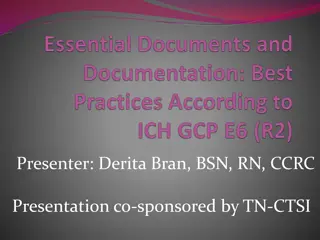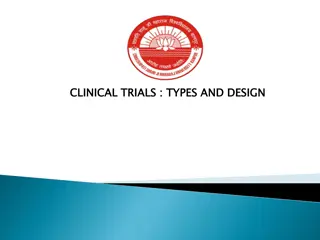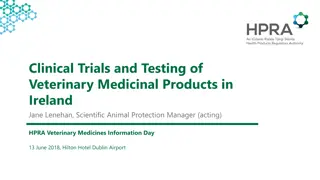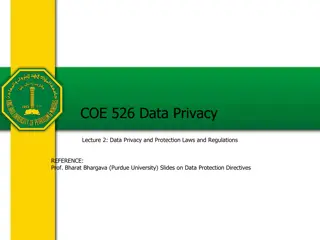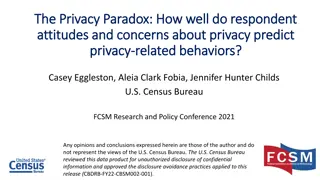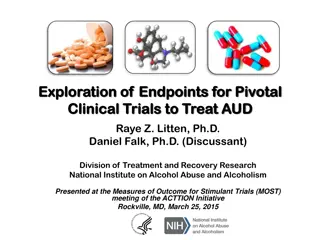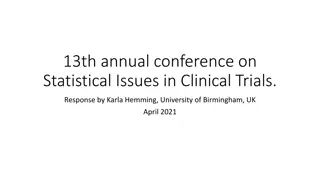Data Privacy in Clinical Trials
Explore the intersection of data privacy and clinical trials, including laws, anonymization, challenges, and practical approaches. Learn about Roche's perspective on data re-use and privacy considerations in research.
Download Presentation

Please find below an Image/Link to download the presentation.
The content on the website is provided AS IS for your information and personal use only. It may not be sold, licensed, or shared on other websites without obtaining consent from the author.If you encounter any issues during the download, it is possible that the publisher has removed the file from their server.
You are allowed to download the files provided on this website for personal or commercial use, subject to the condition that they are used lawfully. All files are the property of their respective owners.
The content on the website is provided AS IS for your information and personal use only. It may not be sold, licensed, or shared on other websites without obtaining consent from the author.
E N D
Presentation Transcript
Internal clinical trial data re-use or what s data privacy got to do with it? Katherine Tucker, Roche Products Ltd. (UK), Data Privacy Technical Lead 9thJune 2020, PSI virtual conference
Agenda Internal clinical trial data re-use or what s data privacy got to do with it? 1. Background including Roche context 2. Data privacy laws and how they apply to clinical trials 3. Role of anonymization 4. Putting it all together - the challenges 5. Practical implementation - how Roche are approaching these issues (work in progress!) 6. Conclusions Disclaimer: This presentation reflects the views of the author and should not be construed to represent Roche s views, policies or endorsements Powering data to accelerate discoveries Powering data to accelerate discoveries
1. Background including Roche context Ensure compliance with privacy/legal/ethical obligations associated with data and their re-use Enable rapid generation of scientific insights from re-use of internal data New/changing data privacy laws and their interpretation in CT context New technologies e.g. WGS, digital pathology New techniques e.g. ML/AI Ethical considerations Defining guardrails to make decisions on appropriate data use Goal of personalised healthcare Powering data to accelerate discoveries
1. Background including Roche context EDIS Roche programme Enhanced Data and Insights Sharing . Maximizing the value of clinical trial data now and in the future Making data F.A.I.R. o Findable o Accessible o Interoperable o Reusable Need another R - responsible re-use including data privacy aspects Broader considerations when re-using data: Advancing science in the interest of patient care, using data maximally for the public good, benefits to society, trust in organisations and ethics. GDPR Recital 4: The processing of personal data should be designed to serve mankind . Powering data to accelerate discoveries Powering data to accelerate discoveries
2. Data privacy/protection laws and how they apply to clinical trials Definitions (simplified) Personal data: information relating to an identified or identifiable natural person ( data subject ); data about identifiable people o Pseudonymised: personal data labelled with a pseudonym (data can t be attributed to a specific data subject without the use of additional information) <- clinical trial data data about non-identifiable people Anonymised data: by taking into account all means reasonably likely to be used, data subjects are no longer identifiable (so out of scope of GDPR); Processing: any set of operations which is performed on personal data (this covers anything you can do with data, including storage in systems); anything you might do with data, including just having it Powering data to accelerate discoveries Powering data to accelerate discoveries
2. Data privacy/protection laws and how they apply to clinical trials Acknowledgement for diagrams: http://gdprmentor.com/gdprmindmap Powering data to accelerate discoveries Powering data to accelerate discoveries
3. The role of anonymisation Anonymisation no single aligned definition, terminology, interpretation or philosophy across the world. One reason is varying data privacy laws across jurisdictions/sectors. GDPR Recital 26 Not Applicable to Anonymous Data Anonymised data: by taking into account all means reasonably likely to be used, data subjects are no longer identifiable ; but what does it really mean? account should be taken of all objective factors, such as the costs of and the amount of time required for identification, taking into consideration the available technology at the time of the processing and technological developments Plus Breyer case (Court of Justice of the EU): IP Addresses & Personal Data Definition established legal means to identify Powering data to accelerate discoveries Powering data to accelerate discoveries
3. The role of anonymization Uniqueness of records within CTs means anon is never achievable Anonymisation common misconceptions: Its only about the data and what you do to it Need to ensure zero risk of re- identification UKAN ADF - Anonymisation is a heavily context-dependent process. Consider data and environment as a total system ( data situation ). Five principles: 2. But you still need to look at the data 4. Zero risk is not a realistic possibility if you are to produce useful data 1. You cannot decide whether data are safe to share/release or not by looking at the data alone 3. Anonymisation is a process to produce safe data but it only makes sense if what you are producing is safe useful data 5. The measures you put in place to manage risk should be proportional to the risk and its likely impact Powering data to accelerate discoveries Powering data to accelerate discoveries
4. Putting it all together - the challenges Aim: use of clinical trial data for internal secondary re-use purposes, in line with data privacy and ethical constraints Possible solutions: 1) Use personal data 2) Create and use anonymised data Secondary re-use Compatible use 1) Use personal data Related regulatory activities Purpose of re-use is key Definitions e.g. primary/secondary use, compatible use, scientific research Role of ICF & data re-use language Legal basis (see definitions) Match planned re-use vs. protocol objectives/ICF language Who decides Protocol objectives Powering data to accelerate discoveries Powering data to accelerate discoveries
4. Putting it all together - the challenges Aim: use of clinical trial data for internal secondary re-use purposes, in line with data privacy and ethical constraints Possible solutions: 1) Use personal data 2) Create and use anonymised data Common to both solutions Global studies, patients across multiple countries Systems, processes, infrastructure Data citizenship & culture, codes of conduct Awareness, training, knowledge Changes to external guidance 2) Create and use anonymised data Definitions e.g. means reasonably likely in internal context Qualitative vs quantitative approach Data changes (SDTM, other modalities) - balance privacy vs. utility Define TOMs (technical & organisational measures) Complexity across data modalities, linkability Limits on use of anon data (scientific research) Powering data to accelerate discoveries Powering data to accelerate discoveries
5. Practical implementation - how Roche are approaching these issues still work in progress! Definition of anonymisation for internal re-use of Roche clinical trial data Clinical trial data use/re-use decision-making flow diagram Powering data to accelerate discoveries Powering data to accelerate discoveries
6. Conclusions: Internal clinical trial data re-use or what s data privacy got to do with it? Responsible data re-use is key in advancing science in the interest of patients and maintaining trust Clinical trial data is personal data under GDPR Personal data can be re-used for compatible/scientific research purposes but needs careful consideration to ensure lawful/ethical The purpose of proposed secondary use is key in knowing what you can and cannot do Using anonymised data for secondary use, where possible, has advantages and may allow a broader scope of re-use purposes A changing data privacy landscape and new emerging external guidance means plans will need to evolve over time Overall: topics are complex, interpretations are evolving, needs a truly cross-functional approach and strong connections between data privacy/legal, IT and the business/data scientists, ideally as part of a comprehensive information/data governance strategy Powering data to accelerate discoveries Powering data to accelerate discoveries
